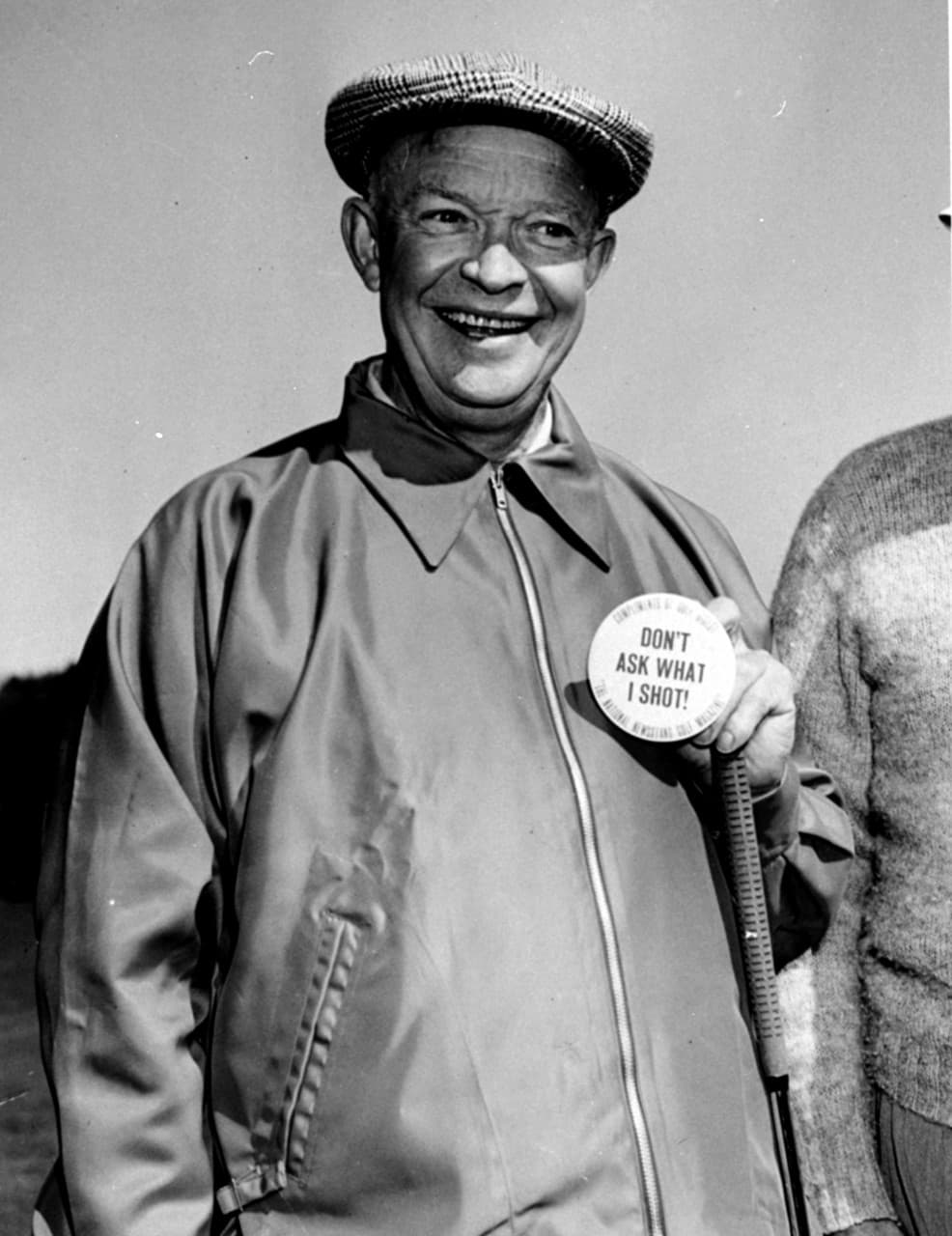Advertisement
Legendary Golfer Gary Player On The Death Of The Eisenhower Tree

The 65-foot-tall Loblolly Pine known as "the Eisenhower Tree" along Augusta National's 17th hole was cut down after it was damaged in an ice storm that hit Georgia and several other states. The tree earned its nickname because it didn’t like Ike.
Former President Dwight Eisenhower hit it so many times between 1948 and 1969 that he lobbied to have the Loblolly removed. He was overruled by then Augusta Chairman Clifford Roberts, and the tree stood until February 2014. But what should Augusta do about it? To answer that question we turned to someone with more than a little knowledge of the course: golf legend and three-time Masters champion Gary Player.
This story originally aired on Feb. 22, 2014.
BL: Gary Player, welcome to Only A Game.
GP: Thank you very much, Bill. And it's quite sad that the tree is gone, but there's always a good side and a bad side. I'm sure President Eisenhower up there in heaven will say, "At last. I've got my wish." But that tree has got a lot of history attached to it. I remember playing there over 50 years ago — almost 60 years ago — and Sam Snead used to just cream it over that tree, and he told [South African golfer] Bobby Cole about that, and Bobby Cole said, "How is that possible?' And he said, "It was only 12-foot high when I did it."

The tree, it really was a very significant tree. It was called a Loblolly pine, and it was over 100 years old which is quite remarkable. ... And in 1962 I had Arnold Palmer by two shots with three holes to go. And nobody had ever won Augusta twice in a row — and I had it in my hands — and he holed a 65-foot putt on number 16 which is impossible to do on that green. Nobody could even two-putt from there.
Anyway, he went on and smashed the ball into the Eisenhower tree, and it rattled in there, and it came down, and I carried it over the tree. I had a nine-iron on the green and he has a five-iron to the green about 28 foot from the hole, and he holes that as well.
Then we went on to do a 18-hole playoff. In those days we didn't have 3-hole playoffs or sudden-death playoffs. It was 18-holes for a major. Thank goodness the U.S. Open still have 18-holes because a major means so much.
But that tree has ruined many, many a score. It was deceptively high because not only was it 65-feet high, but it was up on a hill which really made it closer to 80-foot. And it was very, very deceptive. What should they do? Well, you know, Augusta, they can build a practice tee worth $100 million which nobody else can do. They just go and buy all the houses and make a practice tee out of it. So they can easily replace that tree, and I'm sure there's a big tree somewhere. I'm a great believer of leaving a tree for somebody else to enjoy. And [Augusta] could go in there — and please believe me — they can replace that tree, which I'm sure they'll do.
Advertisement
BL: Well, I'm wondering if Dwight Eisenhower was the only golfer not fond of that tree. There must have been other golfers who had things to say about it. Now keeping in mind that we're public radio and there might be children listening, what have you heard others say about that tree?
GP: I think basically people are sad that it's gone even though it might have hurt them. But it wasn't the tree's fault. It was the golfer's fault. A lot of people like to give the tree the blame, but if [your ball] kicked out on the fairway, you liked it. If it stayed up there, you hated it. And many times the ball actually stayed in the tree because it was so thickly grown together.
BL: So what you're telling me is if somebody were to go through the rubble left over from that tree, they'd find not only splinters they could sell on eBay, but also golf balls?
[sidebar title="Augusta's Pimento Cheese Sandwich Controversy" align="right"]Augusta National made another change in 2013. ESPN's Wright Thompson told us about the new pimento cheese sandwich recipe at the Masters.[/sidebar]GP: [Laughs] It's amazing with a lot of these trees they have in Florida, too. These palm trees when they cut down — I remember they had a tree in San Francisco at the U.S. Open course, and the tree was cut down and they found something like 50 golf balls in it. So, you don't want to tell many people that cause they'll be out with their saw at night. [Laughs]
BL: Have you any favorite — or perhaps least favorite — hazards on other golf courses among the many that you've played over the years?
GP: You know, hazards I always find are the challenging part of the game of golf. I like all these hazards. The 13th hole at Augusta has that hazard right in front of the green and incidentally this is my 40th anniversary going to Augusta. 1974, I won the Masters and the British Open and a lot of other tournaments across the world and was one of my best years. So going back there this year is for me a great thrill. And I've played it 52 times, and I've been there another six or something times, so I'm really close to going there for 60 years.
But the 13th hole at Augusta one year I went for the green and it was a pipe, a drainage pipe that stuck out underneath the green into the hazard by about two feet, and my ball landed against that, and luckily I got a drop. And I chipped it up and holed a putt and went on to win the tournament. So, you know, hazards sometimes are good to you and sometimes they're bad. But if they're bad, you cannot complain because there's no hazard in the middle of the green.
BL: You and your firm have designed more than 300 golf courses in 35 countries. What is it about the design at Augusta National that keeps people interested enough to worry about whether a tree is going to be replaced?
I'm sure President Eisenhower up there in heaven will say, "At last. I've got my wish."
Gary Player, Three-time Masters champion
It's something very, very special, and the fact that it had President Eisenhower and Bobby Jones or Clifford Roberts and a lot of phenomenal great champions throughout history that have won there. It just oozes with a certain atmosphere that is something very special. I've always said, the minute you drive in those gates you start to choke. It's something very special.
BL: I have to get back to President Eisenhower for just one final question. He complained about this tree, and he learned that as president he was not the most powerful man in the United States as far as trees at Augusta was concerned because that was Cliff Roberts. Was Eisenhower just a bad golfer?
[sidebar title="A Historic Masters" align="right"]Tiger Woods won his first major tournament at Augusta National. Fifteen years later, Only A Game's Doug Tribou looked back on Woods' victory in the 1997 Masters.[/sidebar]GP: No, he was pretty good off his handicap. He played off a reasonable handicap, and he was a wonderful man. Arnold Palmer and I had dinner with him one night up in [Palmer's hometown] Latrobe, PA, and he just loved golf which is a great blessing because so many presidents — President Kennedy, President Obama, President Bush, President Clinton — you can go back to all of them. They all loved golf.
What did the man on the moon do when he got there? He didn't kick a football. He hit a golf ball. Other sports you don't stay and play; you play and you get the heck out of there. Now golf, you stay and play. Here I'm nearly 80, and I can beat my age by at least eight to 10 shots a day. I can still play well. I won a tournament at 63. Other sports you're 30 and you're gone.
This segment aired on December 27, 2014.